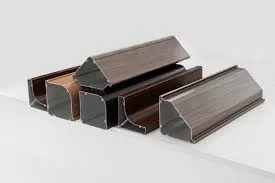wrought iron rusting
The Rusting of Wrought Iron A Comprehensive Overview
Wrought iron, known for its malleability and tensile strength, has been a crucial material in various industries, particularly in construction and the manufacture of decorative elements. Despite its many advantages, wrought iron is susceptible to rusting, a chemical process that can significantly affect its durability and appearance. Understanding the rusting of wrought iron is important for preservation and maintenance in both historical and modern applications.
The Chemistry of Rusting
Rusting is an electrochemical process that occurs when iron reacts with moisture and oxygen in the environment. The fundamental reaction involves the oxidation of iron, leading to the formation of iron oxides, primarily hydrated iron(III) oxide, commonly known as rust. The overall reaction occurs in stages
1. Oxidation of Iron \[ \text{Fe} \rightarrow \text{Fe}^{2+} + 2\text{e}^- \] In this first stage, the iron (Fe) loses electrons to form ferrous ions (Fe²⁺).
2. Oxygen Reduction \[ \text{O}_2 + 4\text{e}^- + 2\text{H}_2\text{O} \rightarrow 4\text{OH}^- \] Oxygen (O₂) in the presence of water (H₂O) gains electrons, producing hydroxide ions (OH⁻).
3. Formation of Rust \[ \text{Fe}^{2+} + 4\text{OH}^- \rightarrow \text{Fe(OH)}_2 \] Eventually, the ferrous ions react with hydroxide ions to form iron(II) hydroxide (Fe(OH)₂), which can further oxidize to form rust (Fe₂O₃·nH₂O).
These reactions illustrate how simple elements can combine to form complex and often damaging compounds, highlighting the necessity of protective measures for wrought iron.
Factors Influencing Rusting
Several factors can accelerate the rusting process of wrought iron
1. Moisture and Humidity The presence of water is essential for rust formation. High humidity levels increase the likelihood of rusting since moisture can condense on surfaces.
2. Oxygen Availability More exposure to oxygen accelerates the rusting process. Environments with high oxygen, such as coastal areas where saltwater enhances oxidation, pose a severe threat.
wrought iron rusting

3. Electrolytes The presence of electrolytic materials such as salt can significantly speed up the rusting process by facilitating the movement of electrons, which enhances the electrochemical reactions that lead to rust.
4. Temperature Higher temperatures can increase the rate of chemical reactions, thereby accelerating rusting. This effect can be seen in warmer climates or during summer months.
5. Protective Coatings The absence of protective coatings drastically increases the susceptibility of wrought iron to rust. Galvanization, painting, and using rust inhibitors are some methods employed to protect the surface of wrought iron.
Prevention and Preservation
Preventing rusting in wrought iron involves employing various strategies
1. Protective Coatings Applying paints, enamels, or galvanization (coating iron with zinc) can create a barrier between the iron and environmental elements, preventing moisture and oxygen from reaching the metal.
2. Regular Maintenance Regular inspection and maintenance are crucial. Rust spots can be treated promptly with sandpaper or wire brushes, followed by repainting to prevent further corrosion.
3. Controlled Environment Storing wrought iron in dry, controlled environments decreases exposure to moisture and humidity, thereby minimizing rusting risk.
4. Use of Corrosion Inhibitors Chemicals that can delay the rusting process may be applied to surfaces or added to paints.
Conclusion
Wrought iron remains an invaluable material in numerous applications due to its unique properties. However, its susceptibility to rusting poses significant challenges. Understanding the chemistry behind rust formation, the factors that influence it, and effective prevention methods are essential for preserving the integrity and aesthetic appeal of wrought iron structures. As society continues to value historical and artistic wrought ironworks, enhanced maintenance and protective techniques will ensure that this magnificent material can endure for generations to come.
-
Window Lock Handle for Security UpgradesNewsJun.20,2025
-
Proper Lubrication Techniques for Sliding Gate WheelsNewsJun.20,2025
-
Ornamental Iron Castings for Interior DesignNewsJun.20,2025
-
Creative Ways to Decorate Around a Cast Iron FireplaceNewsJun.20,2025
-
Cast Iron Pipe and Fitting for Plumbing SystemsNewsJun.20,2025
-
Cast Iron Panel Casting for Architectural ElementsNewsJun.20,2025















